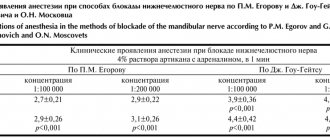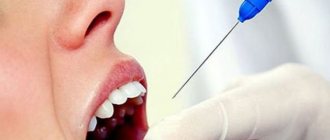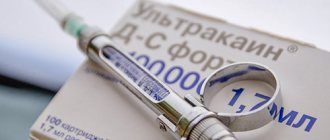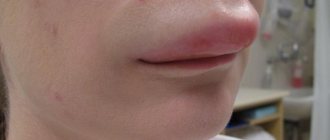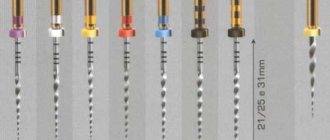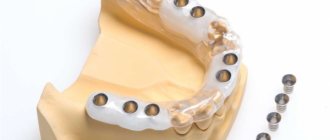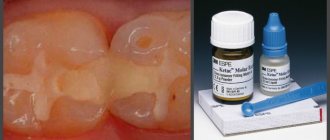The latest technical developments in the field of dentistry expand the capabilities of doctors and make dental procedures more comfortable and safe for patients. Computer anesthesia is the newest alternative to traditional local dental anesthesia.
Dentistry "Sunny Island" has special equipment that makes dental treatment absolutely painless and relieves you of stress and discomfort. The anesthetic is administered slowly under computer control, due to dynamic control, the surrounding tissues are not damaged (as is the case with conventional methods of anesthesia).
The essence of computer anesthesia
The anesthetic is delivered to the nerve endings under low pressure along the path of least resistance. The rate of administration and dosage are determined by the device individually depending on the anatomical and physiological characteristics of the patient. In case of any deviations from the norm, the microprocessor sensor gives an audible and visual signal.
Computer anesthesia technology provides the doctor with all the necessary information in real time. The specialist monitors the correct position of the needle, which eliminates discomfort for the patient. In addition, the needle moves smoothly and evenly, in a circular motion, providing a quick and maximum analgesic effect.
"Freeze"
What is “freezing” and why does it “freeze”? Many of us are mistaken in thinking that it's all about temperature. The loss of sensation as a result of cooling is fundamentally different from anesthesia, which is carried out using an injection with an anesthetic. As such, toothache does not disappear anywhere, but the nerve impulse that transmits the signal about its occurrence to the brain is blocked by an anesthetic. Once in the tissue, the anesthetic deprives the nerve of the ability to conduct pain impulses, changing its electrical potential. The nerve acquires the ability to conduct impulses again after the anesthetic leaves the body, breaking down under the action of special enzymes. The effectiveness and duration of anesthesia directly depends on the correctly selected type of anesthetic, its dose and method of application.
I would also like to note that today anesthesia is carried out not only before the process of “tooth drilling”, but also for the anesthesia manipulation itself! To do this, the planned injection site is “frozen” using a special anesthetic gel, after which the introduction of the needle and the drug becomes absolutely painless.
Advantages of computer anesthesia
The use of a special computerized STA system has the following advantages:
- control of the pressure and rate of anesthetic delivery for maximum effective pain relief (the patient does not feel pressure or distension when the medicine is administered);
- computer anesthesia can be performed in children, pregnant women and people suffering from arterial hypertension;
- damage to ligaments and blood vessels is excluded (which can happen due to excessive stretching or too large a dose of the drug with traditional anesthesia);
- in 9 out of 10 patients, the level of fear and stress decreases when using computer anesthesia (people do not see the syringe and do not experience anxiety, since the working part of the device resembles a fountain pen);
- Only the area in which dental procedures will be performed is anesthetized;
- Thanks to computerized control, the amount of anesthesia used can be reduced without compromising the effectiveness of the procedure.
You can take advantage of dental treatment with computer anesthesia at the Sunny Island dentistry.
Anesthesia and epilepsy
A. Perks1*, S. Cheema3 and R. Mohanraj
Translation into Russian: V. Rubinovich
The prevalence of epilepsy, the most common neurological disorder, is 0.5–1% of the population. Although traditional AEDs (anti-epileptic drugs) still play a significant role, newer agents introduced over the last 20 years are now widely used. Anesthesiologists often deal with patients with epilepsy during elective and emergency procedures, and also deal with seizures and status epilepticus in the intensive care unit. The subject of this review is the perioperative management of epilepsy, the effects of AEDs and their interactions with anesthetics, potential adverse effects of anesthetics, and the management of seizures and refractory status epilepticus in the ICU. Relevant literature was selected by searching PubMed using the terms “epilepsy”, “status epilepticus” in combination with the names of anesthetics.
Key Points
- The authors provided an overview of the mechanisms of action of traditional and new anticonvulsants.
- Awareness of the seizure-provoking properties of certain anesthetics is necessary.
- Status epilepticus, refractory to two antiepileptic drugs, has a high probability of death and requires general anesthesia.
- For uncontrollable seizures, treatment with midazolam, thiopental, or propofol is acceptable; Opioids should be avoided.
Epilepsy is a tendency to repeated spontaneous seizures. The prevalence of this most common neurological disorder is 0.5–1% of the population. A higher frequency is typical for young and old people, as well as for patients with structural or behavioral abnormalities of the brain. The International League Against Epilepsy (ILAE) classifies seizures as focal, or partial, originating in one hemisphere, and generalized, in which electrical seizure activity is initiated in both hemispheres. Lamotrigine and carbamazepine are considered the drugs of choice for focal epilepsy, while valproate is probably most effective for primary generalized seizures. If the initially prescribed AED leads to the development of undesirable effects, a trial of monotherapy with an alternative drug is prescribed. On the other hand, if seizures do not stop with usually adequate doses, a combination of drugs may be necessary.
Over the past 20 years, new generation AEDs have been introduced into practice. Many of them are newly obtained through drug development programs, others are modifications of previously known molecules and are characterized by improved pharmacokinetics. Newer AEDs tend to be less likely to cause side effects and unwanted interactions. Many anesthetics affect seizure activity in both patients with epilepsy and in patients without a history of seizures. In patients taking AEDs, it is important to consider drug interactions and maintenance doses of AEDs during the perioperative fasting period.
Patients with epilepsy often require anesthesia for elective and emergency procedures. Rational perioperative administration of AEDs to control seizures is vital for them. Anesthesiologists should be aware of the pharmacological properties of commonly used AEDs. A patient with epilepsy may require anesthesia in the treatment of status epilepticus - to maintain airway patency or induce general anesthesia for refractory status epilepticus. The purpose of the article is to review the modern treatment of epilepsy, the mechanism of action of AEDs, the action of AEDs during anesthesia and the effect of anesthesia on the course of epilepsy in adults. The use of anesthetics in the management of refractory status epilepticus is also discussed.
Mechanism of action of AEDs
Simply put, seizures can be thought of as the result of an imbalance between excitatory and inhibitory neuronal activity. This leads to hypersynchronous excitation of a large number of cortical neurons. The mechanisms of anticonvulsant activity of traditional AEDs are as follows:
- reduction of incoming voltage-dependent current (Na+,Ca2+);
- increased inhibitory neurotransmitter activity (GABA);
- decrease in excitatory neurotransmitter activity (glutamate, aspartate).
The effects are summarized in table. 1. In addition, new AEDs have an original mechanism of action. New binding sites include synaptic vesicle protein (levetiracetam), GABA receptor steroid sites (ganaxolone), and voltage-dependent potassium channels (retigabine).
| Table 1. Basic mechanisms of action of commonly used AEDs | ||
| Mechanism of action | A drug | |
| Increased GABA activity | ||
| Increasing the frequency of opening of chlorine channels | Benzodiazepines (bind to BZ2 receptors); tiagabine (prevents reuptake); gabapentin (prevents reuptake) | |
| Increasing the average duration of opening of chlorine channels | Barbiturates | |
| Blockade of GABA transaminase (blockade of GABA catabolism within a neuron) | Vigabatrin | |
| Glutamate antagonist | Topiramate | |
| Reduction of incoming voltage-dependent positive currents | Phenytoin (sodium channels); carbamazepine (sodium channels); ethosuximide (calcium channels); | |
| Increase in output voltage-dependent positive currents | Sodium valproate (potassium channels) | |
| Pleiotropic areas of action | Sodium valproate (1, 2, 3, 4), lamotrigine (2, 3), topiramate (1, 2, 3) | |
Effect of AEDs on anesthesia
There are important pharmacokinetic and pharmacodynamic interactions between AEDs and drugs used in anesthesia. This affects both the effectiveness of the drugs and the risk of seizure activity during surgery.
Induction and inhibition of cytochrome P450 isoenzymes in hepatic metabolism represents the most important mechanism of drug interactions involving AEDs. Many older AEDs, such as carbamazepine, phenytoin, phenobarbital and primidone, have potent enzyme-inducing properties. This results in decreased plasma concentrations of many medications, including immunosuppressants, antibiotics, and cardiovascular drugs, especially amiodarone, beta blockers (propranolol, metoprolol), and calcium channel blockers (nifedipine, felodipine, nimodipine, and verapamil).
In patients taking warfarin, initiation and discontinuation of enzyme-inducing AEDs requires careful monitoring of the INR (international normalized ratio, INR). Oxcarbazepine and eslicarbazepine are weaker inducers of microsomal enzymes compared to carbamazepine, but this effect may be clinically significant. Topiramate is also a dose-dependent microsomal inducer. Valproate is an inhibitor of the microsomal system and may reduce the clearance of many medications, including other AEDs. Gabapentin, lamotrigine, levetiracetam, tiagabine and vigabatrin do not induce liver enzymes. Macrolide antibiotics, especially erythromycin, are potent inhibitors of CYP3A4, which is involved in the metabolism of carbamazepine, and can lead to carbamazepine toxicity. The use of carbapenems can lead to a significant decrease in serum concentrations of valproate.
The influence of anesthetics on the course of epilepsy
Many drugs have anticonvulsant or anticonvulsant properties, which may influence the choice of anesthetic.
Inhalational anesthetics
Nitrous oxide causes seizures in animals (cats), but this has not been replicated in humans. In mice, withdrawal seizures were observed after short exposures to nitrous oxide. Electrocorticographic monitoring during surgery for epilepsy while inhaling nitrous oxide showed suppression of epileptiform activity, which resumed when inhalation was stopped. Myoclonus has been observed in volunteers exposed to hyperbaric nitrous oxide (1.5 atm) and when nitrous oxide was combined with isoflurane or halothane. There are numerous reports of seizure-like activity provoked by sevoflurane, especially in children and when high concentrations are used in combination with hypocapnia. At high concentrations, enflurane exhibits periods of suppression with paroxysmal epileptimorphic bursts in cats and rats. There are numerous reports of seizure activity in humans following enflurane anesthesia. Isoflurane has well-documented anticonvulsant properties. Both isoflurane and desflurane can be used for refractory status epilepticus, described in the next section.
Opioids
Meperidine is the opioid most closely associated with myoclonus and tonic-clonic seizures. However, generalized seizures have been reported with low to moderate doses of fentanyl, alfentanil, sufentanil, and morphine, especially when administered intrathecally. No anticonvulsant properties of fentanyl and its analogues have been demonstrated.
Opioids are used to enhance EEG activity in patients with focal epilepsy. Both remifentanil and alfentanil are used to induce spike activity in epileptogenic zones during epilepsy surgery, with alfentanil being the more potent activator. The addition of alfentanil to propofol anesthesia for ECT also increases the duration of seizures.
Intravenous anesthetics
The role of barbiturates (thiopental, methohexital and pentobarbital) in the treatment of refractory status epilepticus is well established. All anesthetics have been reported to produce excitatory activity (myoclonus, opisthotonus and, rarely, generalized convulsions upon induction of anesthesia). This is most commonly observed with etomidate, followed by thiopental, methohexital and propofol. Etomidate, compared with thiopental, has been shown to increase seizure duration during ECT. In higher doses, all of these drugs act as anticonvulsants. The property of ketamine, a non-competitive glutamate antagonist, to act on NMDA receptors may be useful in the management of epilepsy refractory to other drugs. Low doses of ketamine, like other anesthetics, can produce a proconvulsant effect, but in doses that cause sedation or anesthesia, the drug exhibits anticonvulsant properties.
Benzodiazepines
All benzodiazepines have powerful anticonvulsant properties. Diazepam, midazolam, and lorazepam are widely used to abort epilepsy (see below).
Local anesthetics
Local anesthetics readily cross the blood-brain barrier, causing sedation and analgesia and, in higher doses, generalized convulsions. High blood levels may result from inadvertent intravenous injection or rapid systemic absorption from well-vascularized areas. Intravenous lidocaine has been used to treat ES in several small studies, mostly in children. These reports did not indicate any serious adverse effects, but the effectiveness and role of lidocaine in the management of epilepsy is currently unclear.
Neuromuscular conduction blockers
None of the muscle relaxants exhibits either proconvulsant or anticonvulsant properties. Laudanosine, the primary metabolite of atracurium, produces electroencephalographic and clinical signs of seizure activity in animals. This phenomenon has not been reproduced in humans but should be considered in the management of patients with significantly prolonged laudanosine half-life (liver failure). Succinylcholine causes EEG activation associated with increased cerebral blood flow; this effect is partially neutralized by the preliminary administration of a non-polarizing relaxant. It is not associated with seizure activity.
Anticholinergic and anticholinesterase drugs
Increased concentrations of acetylcholine when prescribed atropine or scopolamine can cause central cholinergic blockade (central cholinergic syndrome). It manifests itself as agitation with convulsions, hallucinations and anxiety or stupor, coma and apnea. The most effective treatment is physostigmine. Glycopyrrolate does not penetrate the blood-brain barrier and does not cause such symptoms.
Perioperative prescription of AEDs
When managing patients with well-controlled epilepsy, it is extremely important to avoid perioperative interruption of anticonvulsant therapy. Patients should be advised to take the morning dose of medications on the day of surgery and resume regular dosing as soon as possible after surgery. If one dose is missed (for example, in "one day surgery"), it should be taken as soon as possible after surgery. If many doses are likely to be missed, parenteral AEDs should be prescribed if possible. Oral forms of phenytoin, sodium valproate and levetiracetam are available (IV doses equivalent to oral), and carbamazepine is available in suppository form. If the patient is taking medications that are not available in parenteral forms, a neurologist should be consulted regarding an alternative to cover the perioperative period.
Routine perioperative monitoring of concentrations is usually not required since anesthetics do not have a significant effect on the pharmacokinetics of AEDs. However, prolonged ICU stay, changes in serum pH and albumin levels, and use of drugs that interact with AEDs may affect serum concentrations of anticonvulsants. Of all the commonly used AEDs, phenytoin poses the greatest challenges in this regard due to its unique pharmacokinetics. In ICU patients, serum phenytoin concentrations should be measured daily to adjust dosages.
Status epilepticus
An emergency condition such as ES occurs quite often. The traditional definition of SE is a convulsive seizure that lasts or recurs without restoration of consciousness for more than 30 minutes - it is more useful in epidemiological terms. In clinical practice, most seizures stop within 2-3 minutes; In the case of a seizure lasting more than 5 minutes, there is little chance of spontaneous cessation of seizures, and emergency administration of anticonvulsants should be started.
Physiological changes in SE
During the first stage of convulsive status epilepticus (SES), there is an increase in cerebral metabolism, increased blood flow, and increased concentrations of glucose and lactate. It is associated with massive catecholamine release, increased cardiac output, hypertension, tachycardia, and increased central venous pressure. These compensatory mechanisms prevent brain damage during the first 30-60 minutes. After this time, if seizure control is not achieved, compensatory mechanisms begin to break down and brain damage may occur. Cerebral autoregulation becomes incompetent, leading to hypoxia, hypoglycemia, increased intracranial pressure and cerebral edema. The result is hyponatremia, potassium imbalance, and metabolic acidosis, leading to sweating coagulopathy, rhabdomyolysis, and multiorgan failure. These changes are presented in Figure 1. It should be noted that these changes develop more quickly with SES, but can also occur with non-convulsive status epilepticus (NSE).
Figure 1. Physiological changes during long-term SE. PED, periodic epileptic seizure; CBF, cerebral blood flow. 1, loss of cerebral oxygen tension reactivity; 2, discrepancy between increased utilization of oxygen and glucose and decreased cerebral blood flow; 3, depletion of glucose and glycogen; 4, drop in cerebral energy status.
Stages of GSES (generalized convulsive status epilepticus) and drug treatment
Intervention is required in all cases where a seizure lasts more than 2 minutes longer than the patient's usual seizures. Typically, this means giving an anticonvulsant for seizures lasting 5 minutes. First-line drugs are benzodiazepines. There is evidence that the longer the seizure continues, the less effective treatment becomes. This is due to the impaired localization of GABAergic receptors on the neuronal membrane caused by seizures. Therefore, a benzodiazepine should be started as soon as it is determined that the seizure is not stopping spontaneously. Patients who have experienced one episode of SES, especially those with structural brain abnormalities or learning disabilities, should be prescribed benzodiazepines to prevent refractory SES. Traditionally, rectal diazepam has been used, but buccal or nasal midazolam appears to be equally effective and more acceptable in adult and pediatric patients.
Urgent laboratory evaluation should include arterial blood gases, glucose, renal and hepatic function tests, calcium, magnesium, complete blood count with platelets, coagulation, and AED levels. Consider storing blood and urine samples for subsequent studies, including toxicology, if the cause is unclear. A chest x-ray may be performed to rule out aspiration pneumonia. Other studies may be based on possible etiology (brain imaging, lumbar puncture). When managing SES, respiratory depression often occurs, associated with the sedative effect of anticonvulsants and requiring intubation.
The cause of SES should be determined and treated if possible. Seizures may be associated with alcohol withdrawal and metabolic disturbances, including hypoglycemia and hyponatremia. In patients with epilepsy, the development of SES may be triggered by poor adherence to treatment with a rapid decrease in serum levels of AEDs. SES may be a manifestation of infectious and inflammatory diseases of the brain, which may negatively affect the prognosis of these conditions. Failure to treat the underlying conditions is a common cause of seizures refractory to anticonvulsants.
Premonitory stage (in out-of-hospital conditions or in the first 5 minutes)
Early stage (first 5-10 min)
Initial seizure management is supportive—airway protection, oxygen administration, assessment of cardiorespiratory function, and establishment of venous access. If hypoglycemic seizures are suspected, 50 ml of 50% glucose should be administered immediately. If a malnutrition or alcohol dependence is suspected, a large dose of thiamine (250 mg) should be administered with glucose.
Benzodiazepines are used as first line in the early stages of SES. Although all benzodiazepines have an affinity for the same GABAergic receptor subunits, their pharmacokinetics differ. Lorazepam has demonstrated higher rates of successful seizure control than phenytoin, phenobarbital, and phenytoin with diazepam and is the treatment of choice. If lorazepam is not available, diazepam can be used, but the risk of seizure recurrence is higher due to its rapid redistribution. If venous access is delayed, subsequent doses of rectal diazepam or buccal (nasal) midazolam may be administered. An alternative may be intramuscular midazolam. A study is currently being conducted comparing IM midazolam with the gold standard for the management of early SES, IV lorazepam.
Developed SES (5-30 min)
Currently, 4 drugs are considered as options in the treatment of established SES: phenytoin (or its prodrug, fosphenytoin), valproate, phenobarbital and levetiracetam.
There is little data on their relative effectiveness, and adequate comparative studies are urgently needed.
Phenytoin is probably the most widely used drug in the UK for continued treatment of SES after benzodiazepine administration. It is insoluble in water, and IV forms are highly alkaline. Therefore, phenytoin should only be administered through a large-bore peripheral cannula or central line, as drug extravasation may result in widespread tissue necrosis. Heart rate and blood pressure should also be monitored, as hypotension and bradycardia are possible, especially in the elderly. Fosphenytoin is rapidly converted to phenytoin after IV administration. It can be given more quickly intravenously or intramuscularly and usually causes fewer local complications. However, fosphenytoin is significantly more expensive than phenytoin and is not widely available in the UK.
Phenobarbital has been used as an anticonvulsant for a century and remains the most widely used AED in the world. IV phenobarbital is an alternative to phenytoin as a second-line drug for the treatment of epilepsy. High doses are often required, which carries the risk of sedation. The drug is used infrequently due to concerns about respiratory depression with the benzodiazepine already administered.
An intravenous form of sodium valproate has been available since the late 1990s. and is increasingly used to treat established ES. In a randomized comparative study of IV valproate and phenytoin as first-line treatment for SES in 68 patients, valproate demonstrated a greater seizure freedom rate (66% vs 42%, P.0.05), compared with 79% when comparing these drugs as second line. (vs. 25% phenytoin, which showed ineffectiveness, P,0.005). Participants in this study were not receiving benzodiazepines as first-line medications, which would be the acceptable standard. Therefore, the relative effectiveness data from this study should be interpreted with caution. Moreover, another study comparing these two drugs as initial treatment for epileptic seizures and acute recurrent seizures found no significant difference in efficacy, but valproate appeared to be better tolerated. Acute encephalopathy and hyperammonemia remain potentially serious but fortunately rare complications of valproate therapy.
Several small SES studies (case series) have reported the effectiveness of the newer AED levetiracetam. It is characterized by favorable pharmacokinetic properties, the absence of clinically significant interactions and sedative properties. Its effectiveness as a second-line drug for SES needs clarification. Prospective studies are lacking, but a retrospective analysis of 187 cases of SES treated with levetiracetam, phenytoin, or valproate as second-line agents was recently published. The authors reported that levetiracetam therapy was more likely to fail (48.3%) than valproate therapy (25.4%) (odds ratio 2.69, 95% confidence interval: 1.19–6.08). Phenytoin was not significantly different from the other two drugs (41.4%).
For other AEDs, effective control of SES has been reported with topiramate and lacosamide in a small retrospective case series. Their role in the management of ES remains uncertain.
Refractory status (30-60 min)
Refractory SES (RES), in which the SE continues despite the administration of two AEDs (eg, benzodiazepine and phenytoin), is associated with a high risk of complications, including tachyarrhythmias, pulmonary edema, pyrexia, rhabdomyolysis, and aspiration pneumonia. RES has a high mortality rate, and less than a third of patients recover to premorbid levels.
In patients not responding to other measures, general anesthesia should be initiated and maintained with midazolam, propofolom, or barbiturates (thiopental or pentobarbital). High-dose propofol infusion should be considered with caution due to the risk of propofol infusion syndrome and for this reason it is not recommended in children. An EEG is necessary to titrate doses and to ascertain electrographic signs of cessation of seizures. Maximum therapy should continue until 12-24 hours after the last clinical and electrographic signs of seizures, after which the dose should be reduced. If seizures recur, therapy should be resumed or reconsidered.
Both propofol and thiopental are effective in the treatment of RES. If one of these drugs is ineffective, another can be successfully used. Thiopental provides a lower rate of seizure failure and “breakthrough” seizures, but leads to prolonged recovery, prolongation of ventilation and hospital stay. There are growing concerns about long-term use of high doses of propofol (risk of propofol infusion syndrome). Cardiovascular collapse and mortality have been reported in patients without a history of cardiac disease.
Ketamine may be effective in patients refractory to other drugs. There is also experimental evidence that ketamine may reduce neuronal loss associated with SE. However, this potential benefit must be weighed against the risk of ketamine-related neurotoxicity observed in some cases.
In patients unresponsive to intravenous anesthetics, inhalational anesthesia (isoflurane and desflurane) has been shown to effectively suppress seizure activity on the EEG. In a series of 7 patients, isoflurane concentrations of 1.2-5% were used for an average of 19 days, with occasional recurrence of seizure activity after discontinuation of inhalation. The authors consider this measure as a tool for controlling seizures until regular treatment is established. However, the administration of volatile anesthetics is fraught with technical difficulties.
Nonconvulsive status epilepticus
The term BSES applies to the detection of electrographic seizure patterns on the EEG without obvious clinical phenomena characterizing seizures. In the ICU setting, such patients are usually unconscious. These may be cases of advanced SES, when motor activity weakens over time. Various acute neurological conditions (encephalitis, stroke, trauma and post-circulatory arrest) may also present with coma with electrographic evidence of seizures on the EEG. Detection of BSES usually indicates a worse prognosis for the underlying neurological disease. However, in some of these patients, after treatment with AEDs, the level of consciousness increases. Thus, treatment with AEDs is urgently required for all patients when ES is detected by EEG. The diagnosis of BSES based on EEG, however, is not straightforward, and it may be difficult to identify EEG patterns that require treatment.
In the literature, the term BSEP is also used to describe absence or complex partial ES. Absence status occurs in various idiopathic and symptomatic generalized forms of epilepsy. Complex partial seizures are probably not always recognized and may be more common in older people. Typical manifestations of impaired consciousness with automatisms are not always present. This should be taken into account in the differential diagnosis of all cases of confusion, especially if there is a history of epilepsy or structural abnormalities of the brain. Absence and complex partial statuses are not associated with as severe brain damage as generalized clonic-tonic seizures. The risk of aggressive intravenous therapy is therefore considered unjustified. Adjustment of already prescribed anticonvulsant therapy and the use of oral benzodiazepines is often sufficient to improve the level of consciousness. EEG diagnostics may require the administration of rapid-acting IV AEDs, such as diazepam, at the time of EEG recording to observe the clinical and EEG response.
Non-epileptic seizures (psychogenic non-epileptic seizures)
It should be noted that in specialized centers the number of psychogenic pseudostatuses may exceed the number of true ES. Psychogenic nonepileptic seizures may also occur in the perioperative period. There are many clinical signs that help differentiate them from epileptic seizures. Close clinical observation is key.
conclusions
Anesthesiologists often encounter epilepsy in the perioperative period.
They may also be involved in airway management and general anesthesia in the treatment of status epilepticus. Knowledge of the pharmacology of AEDs and their potential interactions with drugs used in anesthesia is important for the adequate management of patients with epilepsy. Although some anesthetics may precipitate seizures, recovery from anesthesia may be accompanied by tremors and myoclonus, which do not indicate epilepsy. Patients with epilepsy may experience “breakthrough” seizures in the perioperative period, but psychogenic non-epileptic seizures may also occur under these conditions. Status epilepticus is a common neurological emergency that requires urgent intervention. Loss of response to benzodiazepines is a key feature of advanced SES, and prompt anticonvulsant treatment along with resuscitation is necessary. Second-line drugs include phenytoin (fosphenytoin) and valproate, and the effectiveness of new drugs such as levetiracetam and lacosamide has not yet been definitively established. For refractory ES, general anesthesia with midazolam, propofol, or thiopental is currently an acceptable option. Opioids should be avoided. Clinical seizure manifestations may become less obvious over time, and electrographic monitoring is essential to ensure seizure control is achieved. Nonconvulsive status epilepticus should be considered in the differential diagnosis of unconsciousness if its cause is unclear. blog comments powered by Disqus

